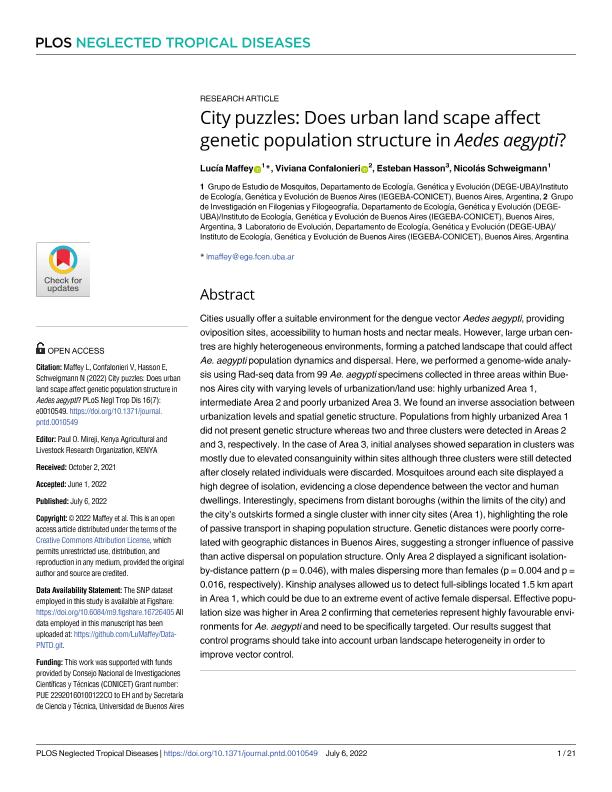Artículo
City puzzles: Does urban land scape affect genetic population structure in Aedes aegypti?
Fecha de publicación:
07/2022
Editorial:
Public Library of Science
Revista:
PLoS Neglected Tropical Diseases
ISSN:
1935-2735
Idioma:
Inglés
Tipo de recurso:
Artículo publicado
Clasificación temática:
Resumen
Cities usually offer a suitable environment for the dengue vector Aedes aegypti, providing oviposition sites, accessibility to human hosts and nectar meals. However, large urban centres are highly heterogeneous environments, forming a patched landscape that could affect Ae. aegypti population dynamics and dispersal. Here, we performed a genome-wide analysis using Rad-seq data from 99 Ae. aegypti specimens collected in three areas within Buenos Aires city with varying levels of urbanization/land use: highly urbanized Area 1, intermediate Area 2 and poorly urbanized Area 3. We found an inverse association between urbanization levels and spatial genetic structure. Populations from highly urbanized Area 1 did not present genetic structure whereas two and three clusters were detected in Areas 2 and 3, respectively. In the case of Area 3, initial analyses showed separation in clusters was mostly due to elevated consanguinity within sites although three clusters were still detected after closely related individuals were discarded. Mosquitoes around each site displayed a high degree of isolation, evidencing a close dependence between the vector and human dwellings. Interestingly, specimens from distant boroughs (within the limits of the city) and the city’s outskirts formed a single cluster with inner city sites (Area 1), highlighting the role of passive transport in shaping population structure. Genetic distances were poorly correlated with geographic distances in Buenos Aires, suggesting a stronger influence of passive than active dispersal on population structure. Only Area 2 displayed a significant isolationby-distance pattern (p = 0.046), with males dispersing more than females (p = 0.004 and p = 0.016, respectively). Kinship analyses allowed us to detect full-siblings located 1.5 km apart in Area 1, which could be due to an extreme event of active female dispersal. Effective population size was higher in Area 2 confirming that cemeteries represent highly favourable environments for Ae. aegypti and need to be specifically targeted. Our results suggest that control programs should take into account urban landscape heterogeneity in order to improve vector control.
Palabras clave:
AEDES AEGYPTI
,
GENETIC STRUCTURE
,
ARBOVIRUS
,
MOSQUITO
Archivos asociados
Licencia
Identificadores
Colecciones
Articulos(IEGEBA)
Articulos de INSTITUTO DE ECOLOGIA, GENETICA Y EVOLUCION DE BS. AS
Articulos de INSTITUTO DE ECOLOGIA, GENETICA Y EVOLUCION DE BS. AS
Citación
Maffey, Lucía; Confalonieri, Viviana Andrea; Hasson, Esteban Ruben; Schweigmann, Nicolas Joaquin; City puzzles: Does urban land scape affect genetic population structure in Aedes aegypti?; Public Library of Science; PLoS Neglected Tropical Diseases; 16; 7; 7-2022; 1-21
Compartir
Altmétricas




